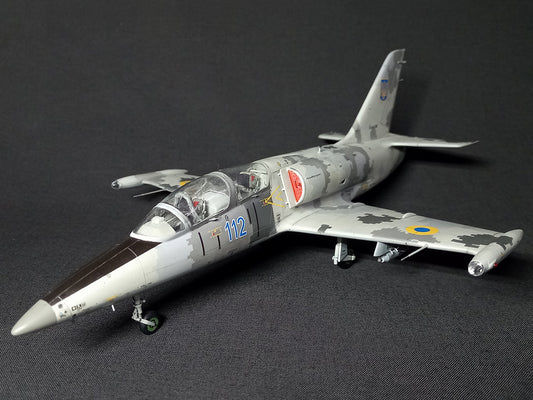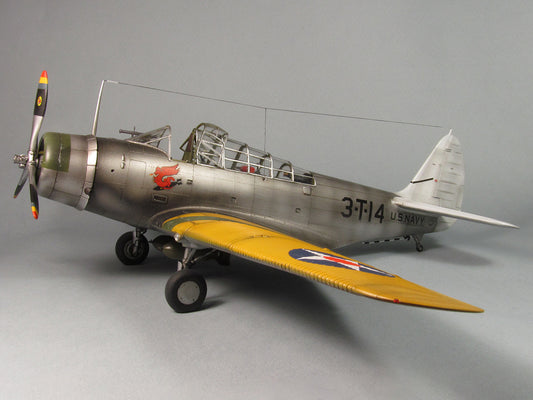By Mykhailo Orlov, Ukraine
CMR, 1/72
Unveiling the British Venom: A Modeler's Journey
Hey fellow aviation enthusiasts,
Today, I'd like to take you on a journey through time and plastic as we delve into the world of scale modeling with a focus on the iconic British de Havilland Venom. This remarkable aircraft, born from the DH.100 Vampire, holds a special place in aviation history, and we'll not only explore its real-world legacy but also dive into the nitty-gritty of building a detailed scale model.
The Historical Context
The de Havilland DH.112 Venom, a twin-boom fighter-bomber, took its maiden flight on September 2, 1949. It served in the Royal Air Force (RAF) and the Royal Navy's Fleet Air Arm, known as the "Sea Venom," from 1952 to 1962. Additionally, this aircraft was exported to eight countries, with a total production of 1480 units.
But what truly makes the Venom stand out is its role in history. These aircraft played their own role during the Suez Crisis of late 1956. Deployed by the RAF's 6th, 8th, and 249th Squadrons, stationed at RAF Akrotiri in Cyprus, these Venoms were part of Operation Musketeer, an Anglo-French intervention in response to Egypt's nationalization of the Suez Canal under General Nasser. The aerial warfare commenced on October 31, 1956, and remarkably, only one RAF Venom was lost during the entire crisis.
The Model Kit

When it comes to scale models of the de Havilland Venom, it's hard to argue against the CMR model in 1/72 scale. This kit boasts an incredible level of detail, and it's cast in resin, which allows for sharp and intricate detailing. It includes a photo etched parts, a vacformed canopy, and various options for paint schemes. For an in-depth look at this kit, you can check out a comprehensive review on internetmodeler.com.
Building the Venom Model
My journey with this particular Venom model was unique because it wasn't for my personal collection; rather, it was a commissioned build for a discerning collector.
The collector's choice was an eye-catching Venom variant, WR444, adorned with vibrant yellow and black stripes on the wings and tail booms. This specific scheme belonged to the 249th Squadron, RAF Akrotiri, circa 1956.
Here are some pictures of aircraft of that Sqadron.


When the model landed in my hands, it was nearly complete. The major assembly work, such as the airframe, landing gear, and armament, had already been done. The model had also been painted. My task was to weather and shade the model, apply the final clear coat, and make sure everything came together seamlessly.
However, the unique construction method of resin models, which differs from traditional plastic kits, posed some challenges. The casting process had left numerous air bubbles in the parts, and the subsequent putty and sanding work had compromised the surface detailing and panel lines. The modeler who had worked on it before me had tried to restore these details but faced difficulties, leading to somewhat messy results.
Making New Panel Recessing
I made the decision to sand down all the panel lines and surface detailing, essentially starting from scratch.

Using references and photographs of surviving Venom aircraft, I created a very general scheme of panel recessing and sketched out the details for photo etched parts.

The result was a pristine, smooth surface ready for priming. Using templates, I carefully re-scribed the panel lines. Additionally, I made photo etched hatches and panels to replace the compromised details.

The de Havilland Venom, despite its modest size in 1/72 scale, presents a complex challenge in terms of re-scribing panel lines. The model's double-curve surfaces and the tendency for templates to shift made it a meticulous process. But with patience and precision, I successfully recreated the intricate panel detailing.
For attaching the photo-etched parts, I used Micro Foil Adhesive from Microscale, which worked excellently for applying these finely detailed panels.


DH Venom Paintwork
Before we even think about applying paint, meticulous preparation is key. The model must be thoroughly cleaned and degreased to ensure the paint adheres correctly. Neglecting this step can result in paint peeling off when we later apply masking tape.
Metallic Details
Let's start with the metallic elements of the Venom. I decided to paint wing tip's fuel tanks and the landing gear bays, in Arcus's Aluminum color. Normally, I'd apply a layer of black underneath metallic colors to enhance their depth. However, due to the small size of these parts, I just skipped this step.

As for the engine nozzle, the real aircraft's Ghost 48 Mk.1 jet engine nozzles were almost black, not the bright shade of Burnt Metal as in the Arcus collection. So, I opted for Gunmetal, which is almost black with a subtle metallic hue. It was a perfect match for this purpose.

After applying these metallic colors, I meticulously masked these areas to ensure they remained pristine during subsequent painting stages.
Nailing the Musketeer Stripes
When painting models, it's crucial to follow a specific sequence, usually from light to dark colors. This helps achieve optimal coverage as lighter colors often have less hiding power than darker ones. However, there can be exceptions.
With that in mind, I decided to paint the distinctive yellow stripes on the Venom, representing its participation in Operation Musketeer. Yellow happened to be the lightest color on this model, making it the logical choice for this stage.

For pre-shading, I initially used regular black paint. However, I later discovered that a dark brown shade works better for pre-shading underneath yellow and red coats. It creates a more organic gradient, avoiding a messy, overly dirty appearance. After the black paint dried, I applied the yellow Musketeer stripes.

While the Arcus palette lacks the BS381C 356 Golden Yellow, which was the original color for the Musketeer stripes, the MAP Yellow from the WWII era is an excellent substitute and was used in this case.
To finalize the Musketeer stripes, I used Night instead of its post-war counterpart, BS381C 642 Night. While these shades have slight differences, they are nearly identical. I applied the Night shade only to the wings, as it appeared that the original camouflage remained visible beneath the yellow stripes on the tail booms. It seemed that the black stripes were not applied in this area.

A Unique Bottom Scheme
Typically, RAF tactical aircraft had High-Speed Silver on their lower surfaces according to the Day Fighter scheme of that time. However, this Venom was based in Cyprus, so a special Overseas scheme was applied, utilizing PRU Blue for the undersides.
After the Musketeer stripes were completed, I pre-shaded the entire model's lower surfaces in preparation for the final PRU Blue coat. This shade was also from World War II, as no modern equivalent was available. Some panels were experimentally painted brown to add variation, showing the effects of repairs during the aircraft's service life. I used RLM 26 Braun from the Luftwaffe palette for this purpose.


However, during the PRU Blue application, I got carried away, and most of the pre-shading and brown panels were almost entirely covered.
Moving to the Upper Surfaces
The upper surfaces of RAF fighters usually sported a camouflage scheme consisting of BS 641 Dark Green and BS381C 638 Dark Sea Grey.
I started with Dark Sea Grey, a lighter color, and pre-shaded it.

After the paint dried, I masked these areas and proceeded with the pre-shading on the remaining unpainted sections. Following this, I applied the BS 641 Dark Green, ensuring the transition between colors was purposefully blurry to mimic the real aircraft's appearance.
Final Touches and Aging
The model received a clear gloss coat, followed by decal application. Unfortunately, the decals turned out to be somewhat finicky and prone to tearing and breaking. Notably, the semi-transparent red decals lacked a white base, which was an oversight.
After the decals, I added the final layers of matte finish and completed the assembly of the de Havilland Venom FB.4 model.
The Venomous Result
In conclusion, my journey with the de Havilland Venom model was not without its challenges, but it was a rewarding experience. This aircraft, with its rich history, offered a unique canvas for my modeling skills, and I'm pleased to say that the end result was a true representation of this iconic aircraft's striking appearance.
Until next time, happy modeling!
Cheers,
Mike














